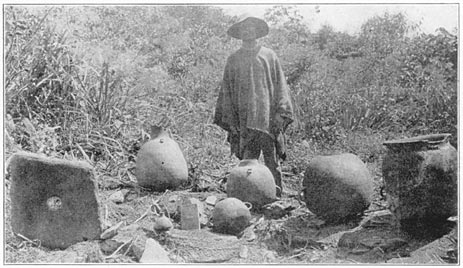Peruvian Historian Claims She Found First Maps Proving that Machu Picchu was Discovered Before Bingham
posted on June 28th, 2008 in Andes Mountains, Archaeology, Did a German Discover Machu Picchu?, Incas, Machu Picchu, Peru, Recent Discoveries
(Above: A Peruvian farmer with looted Inca artifacts in 1911; photo by Hiram Bingham)
Peruvian historian had already published maps of ancient Machu Picchu
June 6, 2008
EFE
(Translated by Kim MacQuarrie)
The Peruvian historian Mariana Mould de Pease published maps in 2003 showing that the famous Inca citadel of Machu Picchu was already known in ancient times and was sacked by the German adventurer Augusto Berns in 1867.
These maps and the history of Berns were made public in an exclusive report last Tuesday by the American cartographer Paolo Greer…
Mould de Pease reminded EFE that the information Greer announced she had published in 2003 in her book “Machu Picchu and the Code of Ethics of the Society of American Archaeology.”
The historian rejected that Berns had been the “discoverer” of Machu Picchu, 44 years before the American explorer Hiram Bingham made known to the world the discovery of the Inca fortress in 1911, and complained that the information she published five years ago has not been made more widely known.
“Since I am Peruvian and a widow, no journalist has paid any attention to me,” she told EFE, and then said that Paolo Greer contacted her and asked for her help when he learned that she had published her book. She added that she had given “a copy of the maps” to the American cartographer, whom she accused of suffering from “discoverer’s syndrome.”
“He has the syndrome of Indiana Jones, of Francisco Pizarro, and of Hiram Bingham—those who want to discover something,” she stated.
She said that she developed a friendship and an exchange of information with Greer and tha recently he insisted that they should publish the progress of their research together. Mould said that, for her part, her findings have been published in various publications, both in Peru as well as in Chile, and that Greer had offered her a fragment of a map, but that the complete map was given to her by the Peruvian archaeologist, Federico Kauffman Doig.
The historian revealed that Hiram Bingham, internationally recognized as the discoverer of Machu Picchu, had among his papers a Supreme Resolution authorizing the presence of Augustus Berns at the historic site.
She pointed out that the English historian, Clements Markham, who became President of the Royal Geographic Society in London, also had maps that had Machu Picchu on them and that in his old age he had maintained a correspondence with Bingham.
“There is a very large map on which (Markham) indicated the location of the historic site,” she said.
Mould de Pease said she worked on the old maps with the librarian, archivist and geographer of the National Library, who confirmed that the coordinates correspond to Machu Picchu.
In this regard, she indicated that Greer decided to publicize the existence of the maps because she informed him that she was going to disseminate her research, which she did last Tuesday in Cuzco, with the help of Congressman Osvaldo Urizar.
“Let Paolo Greer present his maps, and show that he published them before my book in 2003,” she said.
According to an investigation led by the U.S. cartographer Paolo Greer, the fabulous hidden city of the Incas, located at the summit of a mountain about 2,800 meters high, was discovered in 1867 by the gold prospector and timber businessman Augusto Berns, who for years dedicated himself to plundering the ruins and sending the precious archaeological remains to Europe.
The publication of the story about Machu Picchu has aroused great interest in Peru, where this historic site is one of great national pride and is the “jewel in the crown” of tourism.
EFE confirmed today that, according to the Peruvian historian Carlos Carcelén, who worked with Paolo Greer’s team, there are a number of documents and maps that identify the exact location of the citadel, dating long before its “official” discovery in 1911.
Carcelén explained that Berns worked in the Cuzco region and created a lumber and mining company in the second half of the nineteenth century, and then began to loot the ruins of Machu Picchu with the knowledge of the Government at the time.
The historian denounced the existence of significant collections of Inca artifacts in Europe, especially in Germany, which began arriving in the Old World in the late nineteenth century without anyone knowing their origin.
Peru is currently in a dispute with Yale University (USA) over the return of more than 40,000 artifacts from Machu Picchu that were removed by Bingham and never returned.
While the Peruvian government requests the return of all the artifacts, Yale intends to return only 384 pieces within two years to Peru, with the goal of displaying them in a museum to be built in Cuzco under specifications issued by the U.S. institution.
(Upcoming: An Interview with Paolo Greer)

